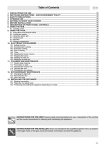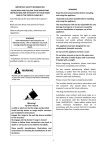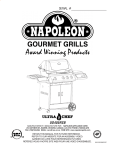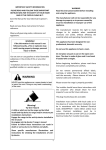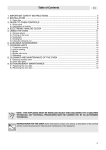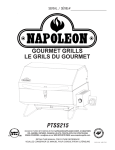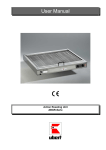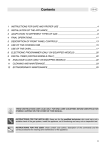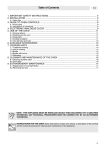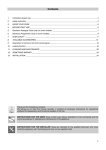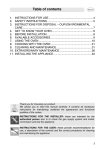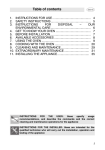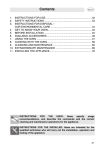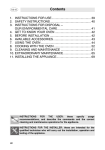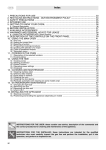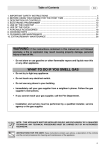Download Smeg SCP111BU2 Instructions for Installation and Use
Transcript
Table of Contents 1. IMPORTANT SAFETY INSTRUCTIONS ................................................................................. 4 2. INSTALLATION ....................................................................................................................... 5 2.1 Oven Use ........................................................................................................................................................ 5 3. OVEN GUIDE .......................................................................................................................... 8 3.1 Control panel ................................................................................................................................................... 9 4. AVAILABLE ACCESSORIES ................................................................................................ 11 5. USING THE OVEN ................................................................................................................ 12 5.1 Warnings and general advice for use ............................................................................................................ 12 5.2 General description ....................................................................................................................................... 12 5.3 Operating modes ........................................................................................................................................... 13 5.4 First use ........................................................................................................................................................ 13 5.5 Selecting a function ....................................................................................................................................... 13 5.6 Programmed cooking procedures ................................................................................................................. 15 5.7 Secondary menu ........................................................................................................................................... 17 6. FUNCTIONS GUIDE ............................................................................................................. 18 7. COOKING SUGGESTIONS AND TIPS ................................................................................. 20 7.1 Suggestions on using the accessories: ......................................................................................................... 20 7.2 General suggestions: .................................................................................................................................... 20 7.3 Suggestions for cooking meat: ...................................................................................................................... 21 7.4 Suggestions for cooking desserts and cookies: ............................................................................................ 21 7.5 Suggestions for defrosting and rising: ........................................................................................................... 21 7.6 Cooking tables: ............................................................................................................................................. 22 8. CLEANING AND MAINTENANCE OF THE OVEN ............................................................... 24 8.1 Cleaning stainless steel ................................................................................................................................ 24 8.2 Regular daily cleaning ................................................................................................................................... 24 8.3 Food stains or residues ................................................................................................................................. 24 8.4 Cleaning the inside of the oven ..................................................................................................................... 24 8.6 Self cleaning: automatic oven cleaning ......................................................................................................... 25 8.7 Before starting the automatic self cleaning cycle .......................................................................................... 25 8.5 Cleaning the door glazing ............................................................................................................................. 25 8.8 Setting the self cleaning cycle ....................................................................................................................... 26 8.9 During and after the self cleaning cycle ........................................................................................................ 26 8.10 Setting the self cleaning cycle with delayed start ........................................................................................ 26 9. SPECIAL MAINTENANCE .................................................................................................... 27 9.1 Replacing oven light bulbs ............................................................................................................................ 27 9.2 Removing the oven door ............................................................................................................................... 27 9.3 Removing the internal glass panes ............................................................................................................... 28 9.4 What to do if... ............................................................................................................................................... 30 NOTE: THIS APPLIANCE MUST BE INSTALLED SOLELY AND EXCLUSIVELY BY A QUALIFIED TECHNICIAN. ANY TECHNICAL PROCEDURES MUST BE CARRIED OUT BY AN AUTHORIZED TECHNICIAN. INSTRUCTIONS FOR THE USER: these instructions contain user advice, a description of the controls and the correct procedures for cleaning and maintenance of the appliance. 3 Important Safety Instruction 1. IMPORTANT SAFETY INSTRUCTIONS READ AND SAVE THESE INSTRUCTIONS – Your safety and the safety of others are very important. We have provided many important safety messages throughout this manual and on the appliance. Read all the instructions before using the appliance and always obey all safety messages. RECOGNIZE SAFETY INFORMATION This is a safety alert symbol. This symbol alerts you to potential hazards that can kill or hurt you and others. UNDERSTAND SIGNAL WORDS A signal word – DANGER, WARNING, or CAUTION – is used with the safety alert symbol. DANGER identifies the most serious hazards. It means you can be killed or seriously injured if you do not immediately follow the instructions. WARNING means you can be killed or seriously injured if you do not follow the instructions. CAUTION indicates a potentially hazardous situation which, if not avoided, may result in minor or moderate injury. - This appliance is intended for home use only. - Only use the appliance for its intended purpose. The manufacturer cannot be held responsible for damages caused by improper use of this oven. WARNING 4 - This appliance complies with current safety requirements. Improper use of the appliance can lead to personal injury and material damage. - Read all the instructions before installing or using the oven for the first time. - Keep these operating instructions in a safe place and pass them on to any future user. Important Safety Instruction 2. INSTALLATION - Before installation, make sure that the voltage and frequency listed on the ID plate correspond with the household electrical supply. This data must be the same to prevent injury or damage to the appliance. Consult a qualified electrician if in doubt. - Make sure your appliance is properly installed and grounded by a qualified technician. - To guarantee the electrical safety of this appliance, it must always be continuously connected to an effective grounding system. This basic safety requirement must be met. If there is any doubt, have your household electrical system checked by a qualified electrician. - The manufacturer is not responsible for damage caused by the lack or inadequacy of an effective grounding system or the failure to meet the requirements of national and local electrical codes. - The oven should not be operated until it has been properly installed within the cabinetry. - Installation, maintenance and repair work should be performed by an authorized service technician. Work by unqualified persons can be dangerous and may void the warranty. - Before installation or service, disconnect the power supply to the work area by “tripping” the circuit breaker, or shutting off the main power. 2.1 Oven Use WARNING BURN HAZARD The oven can produce high temperatures that can cause burns. To reduce the risk of fire, electrical shock, personal injury, or damage when using the oven, follow the basic precautions, including the following: - Prevent children from touching the appliance when in use. - Use heat-resistant pot holders when placing items in the oven, shifting them, or removing them from the oven. The top heating element and oven racks can become very hot and cause burns. - To prevent burns, always place the oven racks at the desired height while the oven is cool. - Always open the door carefully. Allow hot air or steam to exit before food is placed in the oven or removed. - To prevent burns, allow the heating elements to cool before cleaning by hand. - Only clean the parts listed in this manual. - During the self cleaning function the oven will become very warm. Prevent children from coming in contact with the oven. - Remove all accessories from the oven before starting the self cleaning function. The high temperatures needed for this program will damage the accessories. 5 Important Safety Instruction CAUTION: heating elements may be hot even if not glowing. During and after use, do not allow clothing or other flammable materials to come into contact with the heating elements or interior surfaces of the oven until they have had sufficient time to cool. External parts of the oven such as the oven door glass, vent openings and the control panel may also become hot. - Do not obstruct oven vents. - Do not let metal objects (aluminum, foil, metal pans) come into contact with the heating elements. - Do not slide cookware across the bottom of the oven. This could scratch and damage the surface. - Do not lean, sit or place heavy items on the open oven door. The door can support a maximum weight of 75 lbs. (34 kg). - Do not heat unopened food containers in the oven. Pressure could build up and the container could burst. - Never add water to a hot oven tray or pan or pour water directly on food in a hot oven. The steam that is formed could cause serious burns. Any sudden change in temperature can damage the oven's enamel. - This oven must only be used for cooking. Do not use this appliance as a dryer, kiln, dehumidifier, etc. Fumes or vapors given off by glues, plastics or other non-food items could ignite and cause material damage to property and personal injury. - Cover all cooked food that is left in the oven to be kept warm. This will prevent moisture from condensing on the inside of the oven. Long-term or excessive condensation could damage the oven. - Never use aluminum foil to line the oven bottom. Do not place pots, pans or baking sheets directly on the oven bottom when using the top and bottom heating elements, the top and bottom heating elements + convection fan or the convection heating element. This could crack the enamel of the oven bottom. - Never store flammable liquids or materials in, above or under an oven or near cooking surfaces. - Do not use a steam cleaner to clean the oven. Steam can penetrate electrical components and cause a short circuit. - Children should not be left alone or unattended in the area where the oven is in use. Never allow children to sit or stand on any part of the oven. CAUTION: Items of interest to children should not be stored in cabinets above the oven. Children climbing on the oven to reach these items could be seriously injured. 6 Important Safety Instruction - Do not leave the oven unattended when cooking with oils or fats as there is an increased risk of fire if overheated. - Never use water to put out grease fires! - Put the fire out with a properly rated dry chemical or foam-type fire extinguisher. - Be careful of loose-fitting or hanging garments while operating the oven. - Do not use the oven as a room heater. - Make sure that the power cords of small appliances do not come into contact with or get caught in the oven door. - Use only dry, heat resistant potholders. Moist or damp potholders used on hot surfaces may result in burns from steam. Do not let potholders come into contact with hot oil. Do not use towels or other bulky cloth in place of potholders. - Do not clean the door gasket. The door gasket is essential for a good steal. Care should be taken not to rub, damage, or move the gasket. - Do not use Oven cleaners. No commercial oven cleaner or oven liner protective coating of any kind should be used in or around any part of the oven. SAVE THESE INSTRUCTIONS NOTE: The California Safe Drinking Water and Toxic Enforcement Act requires the Governor of California to publish a list of substances known to the State of California to cause cancer, birth defects, or other reproductive harm, and requires businesses to give warning of potential exposure to such substances. WARNING: This product contains a chemical known by the State of California to cause cancer, birth defects, or other reproductive harm. This appliance can cause low-level exposure to some of the substances listed, including benzene, formaldehyde, carbon monoxide, toluene, and soot. 7 Instructions for the user 3. OVEN GUIDE 8 Control panel SELF CLEANING door lock Oven Light Rotisserie motor Rack and tray runners (four levels) Oven door Temperature sensor Oven convection fan ID plate position Instructions for the User 3.1 Control panel All the appliance's control and monitoring devices are placed together on the front panel. The symbols used are described in the table below. Functions and symbols shown: PT1 FUNCTIONS THERMOSTAT KNOB allows to set the time, select the cooking temperature and duration and program the cooking start and end times. Selectable functions, automatic self cleaning cycle DSP3 DSP1 DISPLAY CURRENT TIME This display shows the current time or the cooking PROGRAMMED duration. COOKING PROCEDURES The turning on of the following symbols indicates: Clock: adjusting the cooking time Bell: timer alarm activated. Delayed start: setting the cooking time with a delayed start. Cooking time: setting the cooking time. 9 Instructions for the user Temperature display This display shows the preset temperature for the desired function, or the temperature set by the user. DSP2 The turning on of the following symbols indicates: Temperature The oven is heating up. inside the oven: Child lock-out Child lock-out function mode ON (see “Secondary function: menu” on page 17). Door interlock It turns on when the cleaning cycle is used, to indicator light: indicate that the door has been locked. ON-OFF FUNCTIONS KNOB PT2 10 (PT2) allows access to the oven's three operating modes, and it is also used to select a cooking function or cooking program (see paragraph “5.3 Operating modes”). Instructions for the User 4. AVAILABLE ACCESSORIES Oven rack: for cooking food on pans, small cakes, roasts or food requiring light broiling. Pan rack: goes on top of the pan for food that might drip. Oven pan: useful for catching oil from foods on the rack above. Pastry pan: for baking cakes, pizza and desserts. Roof liner: remove it to make cleaning inside the oven easier. Rotisserie frame: supports the rotisserie rod (see page 20 for instructions for use). Roasting spit: useful for cooking chicken, sausages and anything else requiring uniform cooking over the entire surface. Chromium-plated gripper: useful for removing hot racks and pans. NOTE: Ask your authorized dealer for original accessories. 11 Instructions for the user 5. USING THE OVEN 5.1 Warnings and general advice for use WARNING BURN HAZARD Keep the oven door closed during cooking. NOTE: When using the oven for the first time, heat it to the maximum temperature (500°F) for sufficient time to burn away any oily residues from the manufacturing process. The heating elements and the fan are deactivated when the oven door is opened. NOTE: During cooking, do not cover the bottom of the oven with aluminum or tin foil and do not place pans or oven trays on it as this may damage the enamel coating. If you wish to use greaseproof paper, position it so that it will not interfere with the hot air circulation inside the oven. NOTE: If you have to attend to the food in the oven, leave the door open for the shortest time possible, so that the internal temperature doesn’t drop. To prevent any steam in the oven from creating problems, open the door in two stages: half open (approx. 2 inches) for 4-5 seconds and then fully open. To access food, always leave the door open the shortest time possible, to prevent the temperature in the oven from falling and ruining the food. 5.2 General description 5.2.1 Oven racks The oven features 4 runners for positioning trays and racks at different heights. The insertions heights are numbered from the bottom upwards (see figure). 5.2.2 Cooling system The oven is equipped with a cooling system which begins operating as soon as a cooking function starts. The fan produces a steady flow of air from above the door which may continue for a brief period of time even after the oven has been turned off. 5.2.3 Inside light The oven light comes on when the door is opened or any function is selected, with the exception of the Self Cleaning 12 function. Instructions for the User 5.3 Operating modes This appliance is programmed to provide 3 operating settings, which can be modified by pressing PT2. STAND-BY setting: with DSP1 on and showing the current time (activated as soon as the current time has been confirmed). ON setting: from the stand-by setting, press PT2 once. All the displays and knobs light up. OFF setting: from the ON position, keep PT2 pressed until it turns off. Only the on. symbol on DSP1 remains 5.4 First use When using for the first time, or after a power failure, the oven's left hand-display, DSP1, will show a flashing symbol. To start any cooking operation, the current time must be set. 5.4.1 Setting the current time Adjusting the current time: • turn PT1 to the right and left to increase or decrease the hours respectively. (If the knob is held in one direction the time changes faster). • when PT1 is released, after a few seconds the display will stabilize and only the two dots that separate the hours from the minutes will flash, indicating it is working properly. (The display will also show the symbol ). Note: It might become necessary to change the current time, for example at daylight savings time. Starting from the stand-by setting, (see paragraph "5.3 Operating modes"): • • hold down PT1 for a few seconds until the symbol stops flashing. repeat the operations described in paragraph “5.4.1 Setting the current time”. 5.5 Selecting a function In the ON status only, a cooking function can be selected by simply turning PT2 to the right or left. The selected function will change color to red on the display. After the selection, the preset cooking temperature will be displayed on DSP2. 5.5.1 Cooking at a preset temperature After selecting the desired function, the oven will start the cooking procedure at the preset temperature and the symbol will come on. Cooking itself is preceded by a preheating stage, which allows the oven to heat to the cooking temperature more quickly. The symbol flashes on DSP2 to indicate that this stage is in progress. When the preheating stage is over, the will sound to indicate that the food can be placed inside the oven. symbol will remain on and a buzzer 13 Instructions for the user 5.5.2 Changing the preset temperature The temperature preset for each function can be changed to suit the user's needs. At any time while cooking is in progress, turn PT1 in either direction to increase or decrease the cooking temperature by 5 degrees at a time. (PT1 can also be held to the left or right in order to increase or decrease the setting more quickly.) DEFAULT PRESET (°F) RANGE (°F) ECO function 320 120 - 535 Top and bottom heat 340 120 - 535 Broil 480 120 - 535 Rotisserie with broil 480 120 - 535 Convection with top and bottom heat 320 120 - 535 Convection Broil 480 120 - 535 Convection with bottom heat 320 120 - 535 European convection 320 120 - 535 European convection with top and bottom heat 320 120 - 535 Defrost 85 - Rising 105 - FUNCTION 14 Instructions for the User 5.5.3 Using the timer Press PT1 once (either in the STAND-BY or ON mode). The display will show the on) and the figures (steady symbol (flashing). Turn PT1 to set the cooking time (from 00:01 to 04:00). A few seconds after the desired duration is set, the symbol will stop flashing and remain on; the countdown will start from that moment. Now select the desired cooking function and wait for the buzzer to sound, indicating that the cooking time is over. Press PT1 once to shut off the buzzer; the cooking time can be extended by turning PT1. If the timer was set in STAND-BY mode, when the oven is activated in ON mode (selection of a cooking operation), the counter is reset to zero. Warning: the timer does not stop the cooking process. It only warns the user that the preset number of minutes have expired. Press PT2 to turn off the oven. Modifying the time setting After setting the countdown, press PT1 once. The symbol starts flashing; turn PT1 to change the set duration. A few seconds after the last change, the restart from the new value. symbol will stop flashing, and the countdown will 5.6 Programmed cooking procedures 5.6.1 Semiautomatic cooking Semiautomatic cooking is the function which allows a cooking operation to be started and then ended after a specific length of time that is set by the user. Select a function (see paragraph “5.5 Selecting a function”) and press PT1 twice. The display will show the figures and the symbol (flashing). Turn PT1 to the right or left to set the cooking time (from 00:01 to 23:59). A few seconds after the desired duration is set, the symbol will stop flashing and semiautomatic cooking will start from that moment. At the end, the word STOP will appear on DSP1, cooking will stop and a buzzer will sound; press PT1 to deactivate it. If you wish to continue cooking beyond the set time, press PT1 again. The oven will restart normal operation with the cooking settings selected previously. PT2 has to be pressed to turn the oven off completely. Modifying the setting Once semiautomatic cooking has started, its duration can be changed. When the symbol is steady on and cooking is in progress, press PT1 once. The symbol starts flashing and PT1 can be turned to change the set duration. A few seconds after the last change, the symbol will stop flashing, and semiautomatic cooking will restart from the new value. To change the preset temperature, wait for the symbol to become steady and turn PT1 to the right or left to increase or decrease the cooking temperature. 15 Instructions for the user 5.6.2 Automatic cooking Automatic cooking is the function which allows a cooking operation to be started at a set time and then ended after a specific length of time that is set by the user. Select a cooking function, set the desired cooking temperature or leave the preset temperature (see paragraph “5.5 Selecting a function”) and press PT1 twice. The display will show the figures and the symbol (flashing). Turn PT1 to the right or left to set the cooking time (from 00:01 to 23:59). For safety reasons, when setting automatic cooking the user must first program a cooking duration and then set the cooking start time. It is not possible to set just the cooking start time, without setting the cooking duration. After setting the duration, press PT1 once. The symbol and the current time will appear on the display. Turning PT1 to the right increases the time, allowing the desired cooking start time to be set. A few seconds after the desired duration is set, the and symbols will stop flashing, and the oven will start to wait for the starting time setting. At the end, the word STOP will appear on DSP1, cooking will stop and a buzzer will sound; press PT1 once to deactivate it. If you wish to continue cooking beyond the set time, press PT1 again. The oven will restart normal operation with the temperature settings selected previously. PT2 has to be pressed to turn the oven off completely. Modifying the setting Once automatic cooking has started, its duration can be changed. When the and symbols are steady on and cooking is in progress, or the oven is in stand-by status waiting for cooking to start, press PT1 once. The turned to change the set duration. symbol starts flashing and PT1 can be Press PT1 again; the symbol turns off, the symbol will start to flash, and the cooking start time will be displayed on DSP1. The cooking start time can be increased or decreased by turning PT1. A few seconds after the last change, the and symbols will appear (in steady on mode) on DSP1 and automatic cooking will restart with the new settings. Once cooking has been programmed, before it starts, the function symbol will remain on, as will the symbols 16 , . Instructions for the User 5.7 Secondary menu This appliance also has a concealed "secondary menu" allowing the user to: • Activate or deactivate the child safety device • Activate or deactivate the Showroom mode (which disables all the heating elements so that only the control panel works). Select or deselect the power limiter mode. • In OFF status (see "5.3 Operating modes") hold down PT1 for at least 5 seconds to display the secondary menu. Turning PT1 to the right or left changes the setting status (ON / OFF) or (HI /LO). Press PT1 to proceed to set the next function. Child lock-out mode: activating this mode after two minutes of operation without any intervention from the user the controls will automatically be locked, indicated by the symbol turning on. To disconnect the temporary lock during cooking, hold down PT1 for at least 5 seconds. Two minutes after the last setting the lock will become active again. If a knob is turned, “bloc” appears for 2 seconds. Showroom mode: (only for exhibitors) activating this mode disables all the heating elements so that only the control panel works. To use the oven normally, set this mode to OFF. Power limiter mode: by selecting LO a limited amount of power will be used while cooking. To reset to the appliance normal consumption, select HI. 17 Instructions for the user 6. FUNCTIONS GUIDE ECO FUNCTION: Using the broil and the bottom heating element plus the fan is particularly suitable for cooking small quantities of food, as it consumes a low amount of energy. TOP AND BOTTOM HEAT: As the heat comes from the top and bottom at the same time, this system is particularly suitable for certain types of food. Traditional cooking, also known as static or thermal radiation cooking, is suitable for cooking just one dish at a time. Perfect for all types of roasts, bread, and tarts and in any case particularly suitable for fatty meats such as goose and duck. BROIL: The heat coming from the broil element gives perfect broiling results mostly for thin and medium thickness meats and in combination with the rotisserie (where fitted) gives the food an even browning at the end of the cooking. Perfect for sausages, ribs and ham. This function can be used to broil large quantities of food, particularly meat, evenly. ROTISSERIE WITH BROIL: The rotisserie functions in combination with the broil element, browning food perfectly. CONVECTION WITH TOP AND BOTTOM HEAT: The operation of the fan, combined with traditional cooking, ensures uniform cooking even with complex recipes. Perfect for cookies and cakes, even when simultaneously cooked on several levels. CONVECTION BROIL: The air produced by the fan softens the strong heatwave generated by the broil, giving perfect broiling even for very thick foods. Perfect for large cuts of meat (e.g. pork shank). CONVECTION WITH BOTTOM HEAT: The combination of the fan with just the bottom heating element allows cooking to be completed more rapidly. This system is recommended for sterilizing or for finishing off the cooking of foods already well-cooked on the surface, but not inside, which therefore need a little more heat. Perfect for any type of food. 18 Instructions for the User EUROPEAN CONVECTION: The combination of the fan and the circular element (incorporated in the rear of the oven) can be used to cook different foods on several levels, as long as they need the same temperatures and cooking time. Air circulation ensures the instant and uniform distribution of heat. It will be possible, for instance, to cook fish, vegetables and cookies simultaneously without any smells and flavors mixing. EUROPEAN CONVECTION WITH TOP AND BOTTOM HEAT: The combination of ventilated cooking and traditional cooking can be used to cook different foods on several levels extremely quickly and efficiently. Perfect for large volumes that need intense cooking. DEFROST: Rapid defrosting is aided by turning on the fan and the top heating element ensuring uniform distribution of low temperature air inside the oven. RISING: Rising helped by the heat coming from the top element allows all types of dough to be used, guaranteeing perfect results quickly. 19 Instructions for the user 7. COOKING SUGGESTIONS AND TIPS 7.1 Suggestions on using the accessories: Use only original SMEG trays. When the tray is in the oven, the handle must be facing the oven door. Push the trays right inside the oven. Use only original SMEG racks. When the rack is in the oven, the contoured part must be facing downwards. Push the racks right inside the oven. Use only original SMEG racks. Push the racks right inside the oven. For best cooking results, we recommend placing cookware in the center of the rack. Prepare the rotisserie rod with the food, tightening the screws A of the prongs. Fit the frame B onto the second runner from the bottom. Remove the handle D and position the rotisserie rod so that the pulley E is still in the guides on the frame B. Push the frame B fully in until the tip of the rotisserie rod enters the hole C on the rear wall of the oven. Place an oven pan F on the bottom rack and pour a little water into it to prevent smoke from forming. 7.2 General suggestions: We recommend preheating the oven before putting the food in. Do not place the foods inside the oven until the degrees symbol on the display stops flashing and the beep has sounded to confirm that the set temperature has been reached. For cooking on several levels, we recommend using a convection function to achieve uniform cooking at all heights. In general, it is not possible to shorten the cooking times by increasing the temperature (the food will likely be well-cooked on the outside and undercooked on the inside). During the cooking of desserts and vegetables, dripping from the bottom of the door could occur. This is a natural physical phenomenon which mainly occurs when the food is placed in the oven before preheating. To avoid this, open the door a couple of times during the cooking taking great care. 20 Instructions for the User 7.3 Suggestions for cooking meat: Cooking times, especially for meat, vary according to the thickness and quality of the food and to personal taste. To save energy when roasting, we recommend putting the food in the cold oven. When roasting meat, we recommend the use of a meat thermometer. Alternatively, simply press on the roast with a spoon: if it is hard it is ready, if not, it needs a few more minutes of cooking time. 7.4 Suggestions for cooking desserts and cookies: Use dark metal molds for desserts: they help to absorb the heat better. The temperature and the cooking duration depend on the quality and consistency of the dough. The tables indicate the temperature ranges. Initially, try with the lowest value (the lower temperature gives a more even browning); if the dessert is not cooked to your liking, increase the temperature on the following occasions. Check whether the dessert is throughly cooked: About 10 minutes before the end of the cooking time, stick a toothpick into the highest point in the dessert. If the dough does not stick to the toothpick, the dessert is cooked. If the dessert goes flat when it comes out of the oven, on the next occasion reduce the temperature setting by about 50 °F selecting a longer cooking time if necessary. 7.5 Suggestions for defrosting and rising: We recommend positioning frozen foods in an uncovered container on the first runner of the oven. The food must be thawed without its wrapping. Lay out the foodstuffs to be thawed evenly, with no overlapping. When thawing meat, we recommend using a rack positioned on the second runner with the food on it and a tray positioned on the first runner. In this way, the liquid from the thawing food drains away from the food. The most delicate parts can be covered with aluminum foil. For successful rising, a container of water should be placed in the bottom of the oven. During rising it is recommended that the food is covered with a damp canvas. 21 Instructions for the user 7.6 Cooking tables: Note: The times indicated in the following tables do not include the preheating times. Always make sure you pre-heat the oven and load it when the FUNCTION is steady on. RUNNER TEMPERATURE LEVEL °F FROM BOTTOM TIME IN MINUTES FIRST COURSES LASAGNA Top and bottom heat 1 430 - 450 50 - 60 OVEN-BAKED PASTA Top and bottom heat 1 430 - 450 40 ROASTED VEAL Convection with and bottom heat top 2 360 - 375 70 - 80 PORK LOIN Convection with and bottom heat top 2 360 - 375 70 - 80 PORK SHOULDER European convection with top and bottom heat 2 356 - 375 90 - 100 ROASTED RABBIT European convection 2 360 - 375 70 - 80 TURKEY BREAST Convection with and bottom heat 2 360 - 375 110 - 120 2 360 - 375 190 - 210 2 360 - 375 60 - 70 MEAT ROASTED NECK OF PORK ROASTED CHICKEN top European convection with top and bottom heat European convection with top and bottom heat FIRST SECOND SURFACE SURFACE BROILED MEATS PORK CHOPS Convection Broil 4 535 7-9 5-7 FILLET OF PORK Broil 3 535 9 - 11 5-9 FILLET OF BEEF Broil 3 535 9 - 11 9 - 11 LIVER Convection Broil 4 535 2-3 2-3 SAUSAGES Convection Broil 3 535 7-9 5-6 22 Instructions for the User MEATBALLS Broil 3 535 7-9 5-6 On a rotisserie rod 480 - 535 60 - 70 2 300 - 320 35 - 40 1 480 - 535 6 - 10 ROTISSERIE MEATS CHICKEN Rotisserie with broil FISH SALMON TROUT Bottom circular – fan-ass. PIZZA Convection with and bottom heat BREAD European convection 2 375 - 395 25 - 30 MUFFINS European convection with top and bottom heat 2 355 - 375 15 - 20 DOUGHNUTS Convection with and bottom heat top 2 320 55 - 60 FRUIT TART Convection with and bottom heat top 2 320 30 - 35 SMALL PASTRIES Bottom circular 2 320 - 340 20 - 25 JAM TARTS European convection with top and bottom heat 2 320 20 - 25 PARADISE CAKE Convection with and bottom heat 2 320 55 - 60 ECLAIR European convection with top and bottom heat 2 300 - 320 40 - 50 LIGHT SPONGE CAKE European convection 2 300 - 320 45 - 50 RICE PUDDING European convection with top and bottom heat 2 320 40 - 50 CROISSANTS European convection 2 320 25 - 30 top DESSERTS + fan-ass. top 23 Instructions for the user 8. CLEANING AND MAINTENANCE OF THE OVEN BURN HAZARD WARNING - The oven can produce high temperatures that can cause burns. - To prevent burns, allow the heating elements to cool before cleaning. - Only clean the parts listed in this manual. Do not use a jet of steam for cleaning the inside of the oven. 8.1 Cleaning stainless steel To keep stainless steel in good condition it should be cleaned regularly after use. Let it cool first. 8.2 Regular daily cleaning To clean and preserve the stainless steel surfaces, always use only specific products that do not contain abrasives or chlorine-based acids. How to use: pour the product on a damp cloth and wipe the surface, rinse thoroughly and dry with a soft cloth or deerskin. 8.3 Food stains or residues Do not use metallic scouring pads or sharp scrapers: they will damage the surface. Use normal non-abrasive products and a wooden or plastic tool if necessary. Rinse thoroughly and dry with a soft cloth or deerskin. Do not allow residues of sugary foods (such as jam) to set inside the oven. If allowed to set for too long, they might damage the enamel lining of the oven. 8.4 Cleaning the inside of the oven For best oven upkeep clean regularly after having allowed it to cool. Take out all removable parts. • Clean the oven rack and side runners with hot water and non-abrasive detergent. Rinse and dry. • For easier cleaning, the door can be removed (see paragraph “9.2 Removing the oven door”). The oven should be operated at the maximum heat setting for 15/20 minutes after use of specific products, to burn off the residues left inside the oven. 24 Instructions for the User 8.5 Cleaning the door glazing The glass in the door should always be kept thoroughly clean. Use absorbent paper towel; remove stubborn dirt with a damp sponge and ordinary detergent. Do not use abrasive or corrosive cleaners for cleaning the door glazing (e.g.: powder products, ovencleaner sprays, stain removers and metal scouring pads). Do not use rough or abrasive materials or sharp metal scrapers to clean the oven's glass doors since they may scratch the surface and cause the glass to shatter. 8.6 Self cleaning: automatic oven cleaning Self cleaning is an automatic high-temperature cleaning procedure which causes dirt to dissolve. Thanks to this process, the inside of the oven can be cleaned with great ease. During the first automatic cleaning cycle unpleasant smells may occur due to the normal evaporation of oily manufacturing substances. This is a completely normal phenomenon which disappears after the first cleaning cycle. Before starting the automatic cleaning cycle, make sure that the oven does not contain any foods or large spills from previous cooking operations. During the self cleaning cycle a door interlock device makes it impossible to open the door. IF THE OVEN IS INSTALLED UNDERNEATH A COOKTOP, MAKE SURE THAT THE BURNERS OR ELECTRIC PLATES REMAIN OFF DURING THE AUTOMATIC CLEANING CYCLE. 8.7 Before starting the automatic self cleaning cycle Self cleaning may be carried out at any time of day or night (if you wish to benefit from the lower cost of electricity during the evening). Before proceeding, check the following: • all the accessories have been removed from inside the oven. • the oven door is firmly closed. When setting the cleaning cycle duration, refer to the chart below: LIGHT DIRT MEDIUM DIRT HEAVY DIRT 90 MIN. 135 MIN. 180 MIN. CLEANING DURATION During the automatic self cleaning cycle the fans make more noise because they are running at a higher speed. This is a completely normal function, intended to provide more effective heat dispersal. At the end of the self cleaning process, the fans continue to run automatically in order to prevent overheating of the sides of the cabinet and the front of the oven. 25 Instructions for the user 8.8 Setting the self cleaning cycle 1 With the oven ON, use PT2 to select the self cleaning function. 2 To start the self cleaning cycle, press knob PT1 twice to set its duration. 3 Turn knob PT1 to the right or left to increase or decrease the cycle duration between a minimum of 1h 30m and a maximum of 3h 00m. 4 The message "CLEA" will appear on DSP1 to indicate that the oven is performing the cleaning cycle. 5 The time remaining until the end of the cleaning cycle will be shown on DSP1. 8.9 During and after the self cleaning cycle Two minutes after the self cleaning cycle, an interlock device will activate, preventing the door from being opened. The symbol lights on DSP2 to indicate that this interlock device has been activated. At the end of the cleaning cycle the door interlock device will remain active until the temperature inside the oven has reached a safety threshold. When the oven has cooled down, remove the residues from the automatic cleaning cycle with a damp micro-fibre cloth. Once the door interlock has been activated, no oven functions can be selected. Wait for the symbol to turn off. 8.10 Setting the self cleaning cycle with delayed start 1 Repeat steps 1, 2 and 3 described in “8.8 Setting the self cleaning cycle”. 2 After setting the duration, press PT1 once. The symbol and the current time will appear on the display. 3 Turning PT1 to the right increases the time, allowing the desired cooking start time to be set. 4 A few seconds after the desired duration is set, the symbols stay on, and the oven will start to wait for the starting time setting for the cleaning cycle. 26 Instructions for the User 9. SPECIAL MAINTENANCE The oven may require special maintenance or replacement of parts subject to wear such as seals, bulbs, etc. The following instructions describe how to do these minor maintenance operations. WARNING ELECTRICAL SHOCK HAZARD Before any maintenance operation, disconnect the power supply of the appliance. 9.1 Replacing the oven light Remove upper oven protection A and ring B as well as the glass cover C, unscrewing it anticlockwise. Replace light bulb D. Reassemble ring B, cover C and upper protection A. CAUTION: The standard bulbs are halogen: do not touch them directly with your fingers. Use insulation to protect your hand. Use only bulbs that are available at authorized service centers. NOTE: use only oven bulbs (T 950°F - 500°C) 9.2 Removing the oven door 9.2.1 With moveable levers With the door completely open, lift the levers A until they touch hinges B, then grip the two sides of the door with both hands close to the hinges. Raise the door to an angle of about 45° and remove it. If the hinges don't lock, repeat the operation, raising the levers and keeping the door slightly raised. To remount the door, fit the hinges B into their grooves, then lower the door into place, making sure that it remains in the grooves C, then lower the levers A. 27 Instructions for the user 9.2.2 Removing doors with pins Open the door completely and insert the pins (supplied) into the slots from the inside. Close the door to an angle of about 45° and lift it to remove it. To remount the door, fit the hinges into their grooves, then lower the door into place and extract the pins. In case you lose the pins, two screwdrivers can also be used. 9.3 Removing the internal glass panes Before removing the glass panes, make sure that at least one of the door's hinges has been locked in the open position as described in paragraph “9.2 Removing the oven door”. This operation might have to be repeated during the glass removal process if the door is accidentally freed. WARNING Do not use the appliance without the glass inserted, otherwise the external surface of the door will overheat. The glass in the door should always be kept thoroughly clean. For easier cleaning, it is possible to remove the door (see 9.2 Removing the oven door) and place it on a canvas; or open it and block the hinges in order to extract the glass panes. The glass panes of the door can be completely removed by following the instructions provided below. Removing the internal glass: • Remove the internal glass pane by pulling it towards you, following the movement indicated by the arrows. Doing this dislodges the 4 pins attached to the glass from their slots in the oven door. Removing the middle glass panes: • 28 Remove the middle panes by lifting them upwards. Instructions for the User Cleaning: • The external glass and the previously removed panes can now be cleaned. Use absorbent paper towel. In case of stubborn dirt, wash with a damp sponge and a neutral detergent. Replacing the glass: • Replace the glass panes in the opposite order to which they were removed. • Reposition the internal glass pane, taking care to center and insert the 4 pins attached to the glass into their slots on the oven door by applying light pressure. WARNING Replace the glass panes in the same order and in the same direction that they were removed. Finally, if the door was not removed, unlock the hinges and close it. 29 Instructions for the user 9.4 What to do if... The oven display is completely off • Check the mains power supply. • Check whether an omnipolar switch upstream from the oven feed line is in the “ON” position. • Check whether the “showroom” mode has been set, for further details see paragraph “Secondary menu” on page 17. • Check whether the “child lock-out function” mode has been set, for further details see paragraph “Secondary menu” on page 17. • Check whether the “PO” mode has been set, for further details see paragraph “Secondary menu” on page 17. After the automatic cleaning • cycle it is not possible to select a function. Verify whether the door interlock device has turned off. If it has not, the oven has a protection device that does not allow functions to be selected while the door interlock device is active. This is because the temperatures inside the oven are still too high to allow any type of cooking. The oven does not heat up The controls do not respond. The cooking times are longer than those indicated in the table. The display shows ERR 4 • The fans stop when the door is opened during a convection • function. 30 The door interlock device has not hooked to the door properly. This might be because the door was accidentally opened during its activation. Turn off the oven and turn it on again waiting a few minutes before selecting a new cleaning cycle. This is not a fault. It is a normal operation of the appliance, useful when cooking foods in order to avoid excessive heat from escaping. When the door is closed, the oven will return to normal operation.





























